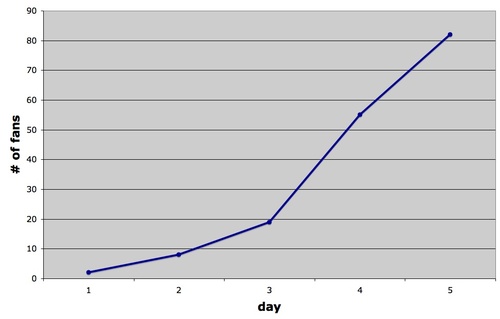I’m a big believer in knowing by doing. So in preparation for my upcoming Stanford class on Creating Infectious Engagement, which will involve a viral marketing project for Facebook, I’ve been messing about a bit over in their part of the world.
This past weekend I set up a "I’m a fan of" page on Facebook for the Stanford d.school. Using some tools built in to Facebook, I sent notice of this fan page to four key connected mavens, and have been tracking the membership stats over the subsequent days. Here’s what the curve looks like, tracking the total number of fans at the end of each day (or at my 10pm bedtime, to be more precise):
I’m not sure what to think about these results. Any comments or ideas from Facebook and/or marketing gurus would be great.


Hey Diego, I think a few attributes:
*passionate “fans” who have friends with similar backgrounds (d.school)
*facebook = virality: newsfeed and fb’s ability to aggregate information meaningfully (newsfeed’s “x of your friends are fans of d.school”)
*content: the page needs some pizzazz! d.school toys, pictures, post-its, vids of class projects, students in action, lecturers, conflicts.. the juicy stuff.
So we’re fans now. Now what? (I imagine fb is asking this q’n internally)
Also, any more room in CIE for add’l projects? I’ve been chewing on one for 8 months…
I had the same thought shared by Min, that is, facebook itself is perhaps the biggest maven(newsfeed etc)…i wonder if those 4 mavens did anything actively to increase the fanship?
And now your blog post will get more traffic(fans) too 🙂
Additionally, it would be interesting to know how many of the fans had previously never heard of the d.school…because perhaps only these would be the ‘true converts’
What would you exactly expect Diego? A pattern similar to an exponential growth curve, or more of a life-cycle S-curve ? Do ‘marketing’ messages spread like a viral epidemic or do they also have a limited lifespan (in being interested, new and capturing attention) … Seems to me the last explanation would be more valid.
Stuck at 100+ for a few days – looks like growth has flattened.
I’d venture your invitation got two generations out before the motivation to become a fan failed to regenerate. Reciprocation (“ok, I’ll play with you”) with the four mavens probably counted for one generation, but further away, that incentive diminished.
There’s little apparent value in remaining an ‘active’ fan (to date), so retention would be a concern if you wanted to avoid a ‘shark’s fin’. (Andrew Chen has some good posts on viral growth, including here. In the comments, see a mention of the classic Bass Diffusion Model).
Stuck at 100+ for a few days – looks like growth has flattened.
I’d venture your invitation got two generations out before the motivation to become a fan failed to regenerate. Reciprocation (“ok, I’ll play with you”) with the four mavens probably counted for one generation, but further away, that incentive diminished.
There’s little apparent value in remaining an ‘active’ fan (to date), so retention would be a concern if you wanted to avoid a ‘shark’s fin’. (Andrew Chen has some good posts on viral growth, including here. In the comments, see a mention of the classic Bass Diffusion Model).